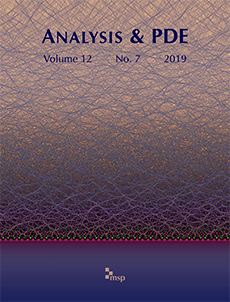Abstract
We are interested in several questions raised mainly by Mancini and Martinazzi (2017) (see also work of McLeod and Peletier (1989) and Pruss (1996)). We consider the perturbed Moser–Trudinger inequality at the critical level , where , satisfying as , can be seen as a perturbation with respect to the original case . Under some additional assumptions, ensuring basically that does not oscillate too fast as , we identify a new condition on for this inequality to have an extremal. This condition covers the case studied by Carleson and Chang (1986), Struwe (1988), and Flucher (1992). We prove also that this condition is sharp in the sense that, if it is not satisfied, may have no extremal.
Citation
Pierre-Damien Thizy. "When does a perturbed Moser–Trudinger inequality admit an extremal?." Anal. PDE 13 (5) 1371 - 1415, 2020. https://doi.org/10.2140/apde.2020.13.1371
Information





